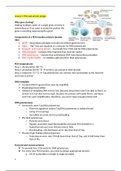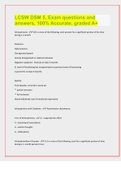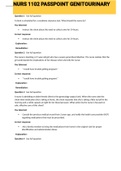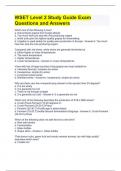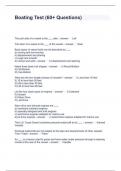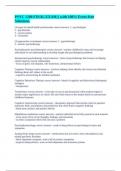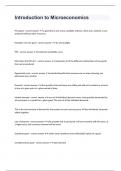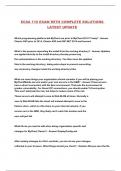Lesson 1 PCR and primer design
Why gene cloning?
Making multiple copies of a single gene, to keep it
somewhere or if we want to study the protein the
gene is encoding (expressing the gene)
Components of a PCR reaction mixture (master
mix)
1. dNTP – deoxyribonucleotides to build new DNA fragments from
2. MgCl2 – Mg2+ ions are required as a cofactor for DNA polymerase
3. Forward- and reverse primer – to provide free 3’OH end for DNA polymerase
4. DNA template – contains DNA fragment that must be copied
5. DNA polymerase – enzyme that synthesizes DNA from deoxyribonucleotides
6. PCR reaction buffer – to stabilize optimal pH for DNA polymerase
PCR temperatures
Step 1: denaturation (98 °C)
Step 2: annealing (50-60 °C) primers can anneal to both strands
Step 3: extension (72 °C) Taq polymerase can connect new nucleotides to the forward-
and reverse primer
DNA template
Ú Contains DNA fragment that must be amplified
Ú Plasmid/genomic/cDNA
Ú Amount of template DNA not too low, because the primers won’t be able to find it to
anneal to it, but also not too high, because the primers will easily find it, and there
won’t be cyclic amplification, therefore, you won’t have enough primers left
DNA polymerases
Ú Commonly used: Taq DNA polymerase
o Thermus aquaticus (where Taq DNA polymerase is isolated from)
o Living in hot springs
o Incredibly accurate, but no proofreading
Ú Pfu DNA polymerase
o Pyrococcus furiosus
o Aquatic anaerobic hyperthermophiles archaeon first isolated in a
hydrothermal vent near Volcano Island, Italy
o Proofreading, ±10-fold lower error rate than that of Taq
Ú Phusion High-Fidelity DNA polymerase
o Featuring an error rate 50-fold lower than that of Taq, and 6-fold lower than
that of Pfu
Forward and reverse primers
Ú To provide free 3’OH ends for DNA polymerase
Ú For every new PCR reaction, you need to design appropriate primers
o 18-24 nucleotides in length & single stranded
1
,Primers design exercise
1. On which side is the 3’ end of the top strand?
On the right
2. On which side is the 3’ end of the bottom strand?
On the left
3. At what side of the DNA does DNA polymerase add nucleotides?
On the 3’ end
4. Where should the annealing position of the forward primer be?
C, because the 3’ hydroxyl end will be on
the right side of the sequence.
Here, the nucleotides will be added.
5. Where should be the annealing position
of the reverse primer?
B, because the 3’ hydroxyl end will be on
the left side of the sequence.
Here, the nucleotides will be added.
When there is only 1 strand given (instead of 2), the forward primers have the same
nucleotides that is on the 5’ side. The reverse primers have the complementary
nucleotides on the 3’ side, but also backwards.
Primers conditions
Ú Forward and reverse primers point towards each other with 3’ ends
Ú No less then 18 nucleotides long for a high specificity
Ú No longer then 24 nucleotides long (Tm would become too high)
Ú CG content ± 50-60%
Ú 3’ end should contain C or G
Ú No internal complementary sequences (hairpin formation)
Ú Not complementary to themselves or to each other (primer dimer formation)
Ú Distance between the primer </=1-2 kb (for regular PCR reaction)
Ú Melting temperature (Tm) below 70 °C Annealing temperature ± 55 to 65 °C
Ú Difference of annealing temperature between primer </= 5°C
Determination annealing temperature for PCR
1. Calculation melting temperature Tm of both primers:
Tm = 4(C+G) + 2(A+T)
2. If Tm is different between both primers, use the lowest Tm to calculate annealing
temperature Ta
3. Annealing temperature Ta = Tm - 2 to 5 °C * Ta should be </= 5°C below Tm of primer with higher Tm
2
, Determination elongation time for PCR
If elongation time is too long: the reaction mixture will run out of dNTP’s
If elongation time is too short: the desired DNA fragment will not entirely be copied
If the annealing temperature during PCR is set TOO LOW for the primers, the primers
will bind a-specifically
If the annealing temperature during PCR is set TOO HIGH for the primers, the
primers will melt of the DNA
During chain elongation, dNTPs are added to the growing DNA strand. The chain
elongation will end when the temperatures changes.
Assignment: design primers to PCR amplify the coding sequence of a gene
1. Determine
the desired amplicon
Between the start and stop codon
2. Determine the forward and reverse primer
Forward: starting at the nucleotide after the start codon
5’ – atggaccagcagattcaga – 3’
Reverse: starting from the stop codon (from right to left)
5’ – tcaacgtcgaaactgtgcg – 3’
3. Determine the annealing temperature for you PCR (difference between both
primers </= 5 °C)
a. Calculate the melting temperature Tm of both primers:
Fw: 5’ – atggaccagcagattcaga – 3’
Tm = 4(C+G) + 2(A+T) 4*(4+5) + 2*(7+3) = 56 °C
Rv: 5’ – tcaacgtcgaaactgtgcg – 3’
Tm = 4(C+G) + 2(A+T) 4*(5+5) + 2*(5+4) = 58 °C
b. If Tm is different between the primers, use the lowest Tm to calculate the
annealing temperature Ta
c. Annealing temperature Ta = Tm – 2 to 5 °C Ta = 56 – 2 = 54 °C
4. Determine the elongation time for a PCR fragment
a. Determine the length of PCR fragment
From 5’ nucleotide forward primer to 5’ nucleotide reverse primer
17*10 + 7 + 3 = 180 bp
b. Taq DNA polymerase needs 60 seconds per 1000 nucleotides – Pfu DNA
polymerase needs 120 seconds per 1000 nucleotides we used Taq for this
experiment, so, 10.8 seconds
3
Why gene cloning?
Making multiple copies of a single gene, to keep it
somewhere or if we want to study the protein the
gene is encoding (expressing the gene)
Components of a PCR reaction mixture (master
mix)
1. dNTP – deoxyribonucleotides to build new DNA fragments from
2. MgCl2 – Mg2+ ions are required as a cofactor for DNA polymerase
3. Forward- and reverse primer – to provide free 3’OH end for DNA polymerase
4. DNA template – contains DNA fragment that must be copied
5. DNA polymerase – enzyme that synthesizes DNA from deoxyribonucleotides
6. PCR reaction buffer – to stabilize optimal pH for DNA polymerase
PCR temperatures
Step 1: denaturation (98 °C)
Step 2: annealing (50-60 °C) primers can anneal to both strands
Step 3: extension (72 °C) Taq polymerase can connect new nucleotides to the forward-
and reverse primer
DNA template
Ú Contains DNA fragment that must be amplified
Ú Plasmid/genomic/cDNA
Ú Amount of template DNA not too low, because the primers won’t be able to find it to
anneal to it, but also not too high, because the primers will easily find it, and there
won’t be cyclic amplification, therefore, you won’t have enough primers left
DNA polymerases
Ú Commonly used: Taq DNA polymerase
o Thermus aquaticus (where Taq DNA polymerase is isolated from)
o Living in hot springs
o Incredibly accurate, but no proofreading
Ú Pfu DNA polymerase
o Pyrococcus furiosus
o Aquatic anaerobic hyperthermophiles archaeon first isolated in a
hydrothermal vent near Volcano Island, Italy
o Proofreading, ±10-fold lower error rate than that of Taq
Ú Phusion High-Fidelity DNA polymerase
o Featuring an error rate 50-fold lower than that of Taq, and 6-fold lower than
that of Pfu
Forward and reverse primers
Ú To provide free 3’OH ends for DNA polymerase
Ú For every new PCR reaction, you need to design appropriate primers
o 18-24 nucleotides in length & single stranded
1
,Primers design exercise
1. On which side is the 3’ end of the top strand?
On the right
2. On which side is the 3’ end of the bottom strand?
On the left
3. At what side of the DNA does DNA polymerase add nucleotides?
On the 3’ end
4. Where should the annealing position of the forward primer be?
C, because the 3’ hydroxyl end will be on
the right side of the sequence.
Here, the nucleotides will be added.
5. Where should be the annealing position
of the reverse primer?
B, because the 3’ hydroxyl end will be on
the left side of the sequence.
Here, the nucleotides will be added.
When there is only 1 strand given (instead of 2), the forward primers have the same
nucleotides that is on the 5’ side. The reverse primers have the complementary
nucleotides on the 3’ side, but also backwards.
Primers conditions
Ú Forward and reverse primers point towards each other with 3’ ends
Ú No less then 18 nucleotides long for a high specificity
Ú No longer then 24 nucleotides long (Tm would become too high)
Ú CG content ± 50-60%
Ú 3’ end should contain C or G
Ú No internal complementary sequences (hairpin formation)
Ú Not complementary to themselves or to each other (primer dimer formation)
Ú Distance between the primer </=1-2 kb (for regular PCR reaction)
Ú Melting temperature (Tm) below 70 °C Annealing temperature ± 55 to 65 °C
Ú Difference of annealing temperature between primer </= 5°C
Determination annealing temperature for PCR
1. Calculation melting temperature Tm of both primers:
Tm = 4(C+G) + 2(A+T)
2. If Tm is different between both primers, use the lowest Tm to calculate annealing
temperature Ta
3. Annealing temperature Ta = Tm - 2 to 5 °C * Ta should be </= 5°C below Tm of primer with higher Tm
2
, Determination elongation time for PCR
If elongation time is too long: the reaction mixture will run out of dNTP’s
If elongation time is too short: the desired DNA fragment will not entirely be copied
If the annealing temperature during PCR is set TOO LOW for the primers, the primers
will bind a-specifically
If the annealing temperature during PCR is set TOO HIGH for the primers, the
primers will melt of the DNA
During chain elongation, dNTPs are added to the growing DNA strand. The chain
elongation will end when the temperatures changes.
Assignment: design primers to PCR amplify the coding sequence of a gene
1. Determine
the desired amplicon
Between the start and stop codon
2. Determine the forward and reverse primer
Forward: starting at the nucleotide after the start codon
5’ – atggaccagcagattcaga – 3’
Reverse: starting from the stop codon (from right to left)
5’ – tcaacgtcgaaactgtgcg – 3’
3. Determine the annealing temperature for you PCR (difference between both
primers </= 5 °C)
a. Calculate the melting temperature Tm of both primers:
Fw: 5’ – atggaccagcagattcaga – 3’
Tm = 4(C+G) + 2(A+T) 4*(4+5) + 2*(7+3) = 56 °C
Rv: 5’ – tcaacgtcgaaactgtgcg – 3’
Tm = 4(C+G) + 2(A+T) 4*(5+5) + 2*(5+4) = 58 °C
b. If Tm is different between the primers, use the lowest Tm to calculate the
annealing temperature Ta
c. Annealing temperature Ta = Tm – 2 to 5 °C Ta = 56 – 2 = 54 °C
4. Determine the elongation time for a PCR fragment
a. Determine the length of PCR fragment
From 5’ nucleotide forward primer to 5’ nucleotide reverse primer
17*10 + 7 + 3 = 180 bp
b. Taq DNA polymerase needs 60 seconds per 1000 nucleotides – Pfu DNA
polymerase needs 120 seconds per 1000 nucleotides we used Taq for this
experiment, so, 10.8 seconds
3


